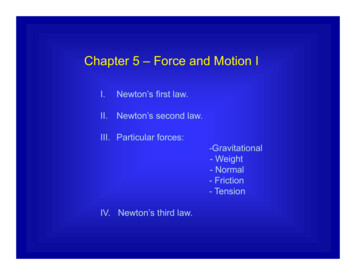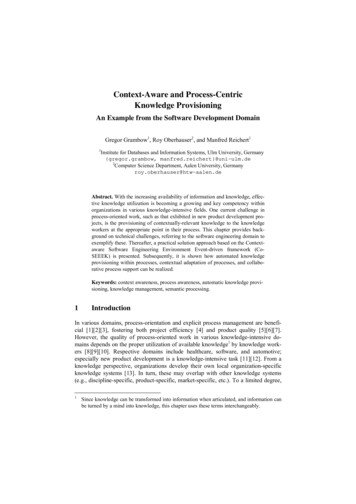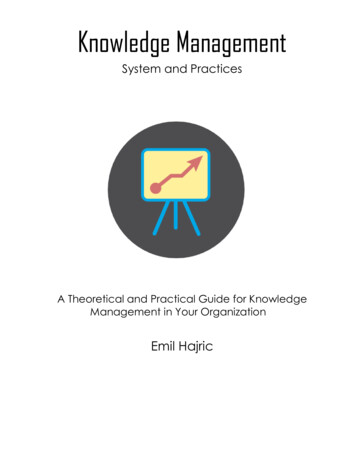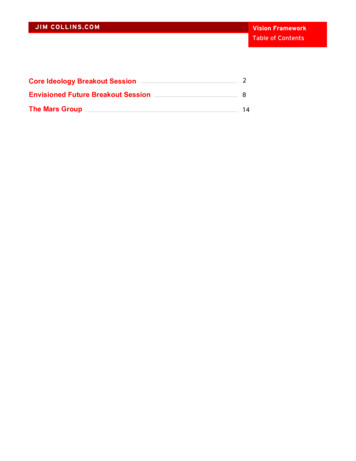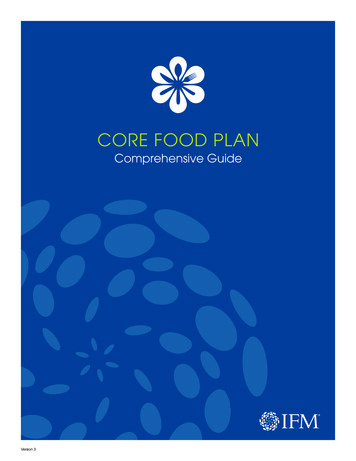
Transcription
National Association of Certified Valuators and AnalystsThe Core Body of Knowledge for Master Analyst inFinancial Forensics (MAFF)All rights reserved. No part of this work covered by the copyrights herein may be reproduced or copiedin any form or by any means—graphically, electronically or mechanically, including photocopying,audio/video recording or information storage and retrieval of any kind—without the express writtenpermission of the National Association of Certified Valuators and Analysts. 2020 National Association of Certified Valuators and AnalystsRev 04/10/20Page 1
The Core Body of Knowledge for MAFFTable of ContentsPart I: Foundations of Financial Forensics. 4I.Professional Responsibilities . 4II.Laws, Courts, and Dispute Resolution . 4III. Practice Management. 4IV. Information Gathering and Preserving . 4V.Role of a Financial Forensic Specialist . 4Part II: Specialty Areas—Commercial and Personal Damages . 5I.Calculating Business Damages . 5II.Personal Damages . 5III. Presenting Damage Calculations—Report Writing . 6IV. Economic Theory and Modeling . 6Part II: Specialty Areas—Business and Intellectual Property Damages . 7I.Intellectual Property Damages—Overview . 7II.Patent Damages . 7III. Trademark Damages—The Lanham Act. 7IV. Copyright Damages . 7V.Trade Secret Damages . 7Part II: Specialty Areas—Business Valuation in Litigation . 8I.Business Valuation as a Measure of Damages . 8II.Business Valuation Reports in Litigation . 8III. Dissenting/Oppressed Shareholder Litigation . 8IV. Bankruptcy Litigation and Valuations . 8V.Marital Litigation and Valuation . 8VI. Buy Out Litigation . 8Part II: Specialty Areas—Matrimonial. 9I.Asset Distribution . 9II.Alimony and Child Support. 9III. Taxation . 9IV. Forensic Analysis . 9V.Alternative Dispute Resolution (ADR). 10Part II: Specialty Areas—Business Fraud and Deterrence . 11I.Audits Versus Investigations . 11II.Definition of Fraud . 11III. Red Flags of Fraud . 11IV. Fraud Investigation Procedures . 11V.Classification of Occupational Fraud Schemes . 11 2020 National Association of Certified Valuators and AnalystsRev 04/10/20Page 2
The Core Body of Knowledge for MAFFVI. Fraud Investigation and Corrective Action . 11VII. Interviewing . 12VIII. Reporting. 12IX. Fraud Risk Management . 12Part II: Specialty Areas—Bankruptcy, Insolvency, and Restructuring. 13I.Introduction . 13II.Turnaround Management . 13III. Bankruptcy Law . 13IV. Debtor in Possession Under Chapter 11 . 13V.Plan of Reorganization. 13VI. Typical Roles of Financial Professionals . 13Part II: Specialty Areas—Digital Forensics. 14I.Data Architecture . 14II.Types of Data . 14III. Data Integrity Fem 3.722 . 14IV. Forensic Investigation Process—Objectives . 14V.What Digital Forensics Can Reveal . 14VI. Structured Methodology for Investigation. 14VII. Cost—Benefit Analysis. 14VIII. Cyber Crime—AKA Ecrime . 14 2020 National Association of Certified Valuators and AnalystsRev 04/10/20Page 3
The Core Body of Knowledge for MAFFPart I: Foundations of Financial Forensics(Percentage Emphasis on MAFF Exam20%)I.II.III.IV.V.Professional ResponsibilitiesA. Authoritative Professional Standards—NACVA and otherB. Responsibilities of Independent AccountantC. Ethical IssuesD. Liability IssuesE. RolesLaws, Courts, and Dispute ResolutionA. Federal and State Rules of Evidence and ProcedureB. Court System—Federal and StateC. Alternative Dispute ResolutionPractice ManagementInformation Gathering and PreservingA. Document and Evidence GatheringB. Client RecordsC. Other Party RecordsD. Document and Evidence Preservation and RetentionE. Paper RecordsF. Electronic RecordsG. Requesting and Examining Other Parties’ InformationH. Document ProductionI. Document Management and ControlJ. Work PapersK. SubpoenaRole of a Financial Forensic SpecialistA. Supervision and ControlB. Fact FindingC. Reports and ExhibitsD. Experts1. Consulting Expert2. Testifying Expert3. OtherE. Motions in Limine1. Daubert2. Kumho Tire3. Kelly-Frye 2020 National Association of Certified Valuators and AnalystsRev 04/10/20Page 4
The Core Body of Knowledge for MAFFPart II: Specialty Areas—Commercial and Personal Damages(Percentage Emphasis on MAFF Exam12%)I.Calculating Business DamagesA. Components1. Measures of LossaLost profitsb Lost business valuecAlternative causes of action and related damages2. Elements of Lost ProfitsaProximate causeb ForeseeabilitycReasonable certaintyd Mitigation3. Methods to Calculate Lost ProfitsaBefore and After Methodb Yardstick MethodcSales Projection Methodd Market Model MethodB. Liability and CausationC. The Damage PeriodD. Discounting Future DamagesE. Interest Rates/Discount RatesF. Ex-ante vs. Ex-postG. Tax Treatment of DamagesH. Comparison of Business Valuation and Lost Profits ApproachesI. New Business Rule/Start-upsJ. Damages for Non-profitable BusinessesII. Personal DamagesA. Personal InjuryB. Wrongful DeathC. Lost EarningsD. Medical ExpensesE. Work/Life ExpectancyF. Personal ConsumptionG. Household ServicesH. Punitive Damages 2020 National Association of Certified Valuators and AnalystsRev 04/10/20Page 5
The Core Body of Knowledge for MAFFPart II: Specialty Areas—Commercial and Personal Damages (continued)III. Presenting Damage Calculations—Report WritingA. Communications with CounselB. Vocabulary/GrammarC. Formats1. 26(a)2B2. Valuations in a Litigation ContextD. Standards Applicable for Report Writing1. Federal2. StateIV. Economic Theory and Modeling 2020 National Association of Certified Valuators and AnalystsRev 04/10/20Page 6
The Core Body of Knowledge for MAFFPart II: Specialty Areas—Business and Intellectual Property Damages(Percentage Emphasis on MAFF Exam12%)I.II.III.IV.V.Intellectual Property Damages—OverviewA. Types of Intellectual Property1. Patents2. Trademarks3. Copyrights4. Trade SecretsB. Proper Methodology Rests in Conventional Valuation TheoryC. How Does IP Drive ValuePatent DamagesA. Lost Profits or Reasonable Royalty1. Panduit Factors2. Costs of Designing Around the Patent3. Cost to Develop or Reproduce4. Determination of Lost RevenuesB. Reasonable Royalty RevenuesC. Hypothetical NegotiationD. Georgia-Pacific FactorsE. The Value of the TechnologyF. Approaches Used are the Same as Any ValuationG. 25% RuleH. Sources of Information—IndustryTrademark Damages—The Lanham ActA. Primary Difference in Trademark Cases vs. Patent CasesB. Primary Categories of Trademark Damages1. Defendant’s profits2. Damages sustained by plaintiffC. Lanham Act DamagesCopyright DamagesA. DefinitionB. Federal LawC. Registration RequirementD. Fair UseE. Differences from PatentsF. Differences from TrademarksG. Federal Law Relating to Copyright Damages: Title 17, Section 504 of U.S. CodeTrade Secret DamagesA. DefinitionB. Uniform Trade Secrets ActC. Measuring DamagesD. Differences from Patents, Trademarks, and Copyrights 2020 National Association of Certified Valuators and AnalystsRev 04/10/20Page 7
The Core Body of Knowledge for MAFFPart II: Specialty Areas—Business Valuation in Litigation(Percentage Emphasis on MAFF Exam12%)I.II.III.IV.V.VI.Business Valuation as a Measure of DamagesA. Professional StandardsB. Rev Rul. 59-60 and Related1. Eight Factors2. Fair Market Value CriteriaC. Rev Rul. 77-287 and Related1. Discounts for Lack of Marketability (DLOM)2. Valuation of SecuritiesD. Statutory Value and Other Standards of ValueBusiness Valuation Reports in LitigationA. Rules of Civil ProcedureB. FRCP 26(a)(2)(B):Dissenting/Oppressed Shareholder LitigationA. Dissenters RightsB. Shareholder OppressionC. Judicial Approaches to Oppression1. Bad Faith2. Fiduciary Duty3. Reasonable ExpectationsD. Business Judgment RuleBankruptcy Litigation and ValuationsA. Legal Declaration of the Inability or ImpairmentB. Constituencies:1. Trustee2. Debtor3. Security (Equity) Holders4. Secured CreditorsC. Typical Premise of Value1. Orderly Liquidation Value2. Forced Liquidation Value3. Going Concern Value4. Reorganization ValueD. Tangible and Intangible AssetsMarital Litigation and ValuationA. Standards of ValueB. Approaches and MethodologyC. Goodwill IssuesBuy Out Litigation 2020 National Association of Certified Valuators and AnalystsRev 04/10/20Page 8
The Core Body of Knowledge for MAFFPart II: Specialty Areas—Matrimonial(Percentage Emphasis on MAFF Exam12%)I.Asset DistributionA. Property DivisionB. Post-marital Appreciation of PropertyC. Community Property StatesD. Equitable Distribution StatesE. Separate PropertyF. Community PropertyII. Alimony and Child SupportA. Factors Considered by CourtsB. Pendente LiteC. Rehabilitative AlimonyD. Term AlimonyE. Reimbursement AlimonyF. Temporary vs. Permanent AlimonyG. Family Support Act of 1988III. TaxationA. Married JointB. Married SeparateC. Head of HouseholdD. Exemptions for ChildrenE. CreditsF. AlimonyG. Child SupportH. Effect of BankruptcyI. Entity vs. Professional GoodwillJ. Innocent SpouseK. QDROL. IRA TransfersM. Non-qualified PlansN. Alimony RecaptureIV. Forensic AnalysisA. LifestyleB. Hidden IncomeC. Hidden AssetsD. Allocation Analysis and Equalization PaymentsE. Income Measurement and ReconstructionF. Business ValuationG. PensionsH. FLPs—No Answers—Only QuestionsI. Employee Stock Options, Restricted Stock, and Equity AwardsJ. Other Asset Valuations 2020 National Association of Certified Valuators and AnalystsRev 04/10/20Page 9
The Core Body of Knowledge for MAFFPart II: Specialty Areas—Matrimonial (continued)V. Alternative Dispute Resolution (ADR)A. ArbitrationB. MediationC. Collaborative DivorceD. Complimentary Dispute Resolution 2020 National Association of Certified Valuators and AnalystsRev 04/10/20Page 10
The Core Body of Knowledge for MAFFPart II: Specialty Areas—Business Fraud and Deterrence(Percentage Emphasis on MAFF Exam12%)I. Audits Versus InvestigationsA. Financial Statement AuditsB. Accountants’ Services Related to FraudC. Sarbanes-Oxley Act of 2002II. Definition of FraudA. Elements of FraudB. Fraud TriangleIII. Red Flags of FraudA. Structural Red FlagsB. Behavioral Red FlagsC. Accounting System Red FlagsIV. Fraud Investigation ProceduresA. Analytical ReviewB. Financial RatiosC. Examination of AccountsD. Sources of InformationV. Classification of Occupational Fraud SchemesA. Asset Misappropriation1. Cash Receipts Schemes2. Cash Disbursement Schemes3. Non-Cash SchemesB. Bribery and Corruption1. Bribery2. Kickbacks3. Extortion4. Conflicts of Interest5. Foreign Corrupt Practices Act (FCPA)C. Financial Statement Fraud1. Revenue Overstatement2. Asset Overstatement3. Liability Understatement4. Expense Understatement5. Other SchemesVI. Fraud Investigation and Corrective ActionA. Fraud Investigation and Response ProtocolsB. Investigation Techniques 2020 National Association of Certified Valuators and AnalystsRev 04/10/20Page 11
The Core Body of Knowledge for MAFFPart II: Specialty Areas—Business Fraud and Deterrence (continued)VII. InterviewingA. Identifying DeceptionB. Interview Planning and PreparationC. Interview ConductD. Interview ProcessVIII. ReportingIX. Fraud Risk ManagementA. Fraud Risk AssessmentB. Internal ControlsC. Fraud Prevention 2020 National Association of Certified Valuators and AnalystsRev 04/10/20Page 12
The Core Body of Knowledge for MAFFPart II: Specialty Areas—Bankruptcy, Insolvency, and Restructuring(Percentage Emphasis on MAFF Exam10%)I.II.III.IV.V.VI.IntroductionA. Defining Business DistressB. Causes of Financial DifficultyC. Stages of Financial FailureTurnaround ManagementA. Elements of Turnaround ManagementB. Stages of Turnaround ProcessC. Alternatives Available to Bankruptcy ProceedingsBankruptcy LawA. Bankruptcy Law and CourtsB. Nature of InsolvencyC. Provisions Common to all ProceedingsD. Classifications and Priorities of Claims and InterestsDebtor in Possession Under Chapter 11A. Commencement of the CaseB. Operating Under Chapter 11C. Reporting While in Chapter 11D. Exiting Chapter 11Plan of ReorganizationA. Developing the Plan of ReorganizationB. Confirming the Plan of ReorganizationC. Financial Elements of the Plan of ReorganizationD. Post-Confirmation Issues/Discharge of DebtTypical Roles of Financial ProfessionalsA. Factfinding InvestigationsB. Bankruptcy Litigation Support ServicesC. Business Valuators and Distressed Business Valuation IssuesD. Accountants and Financial Reporting for the Debtor in PossessionE. Auditors and Auditing the Distressed CompanyF. Income Tax Advisors and Income Tax Issues 2020 National Association of Certified Valuators and AnalystsRev 04/10/20Page 13
The Core Body of Knowledge for MAFFPart II: Specialty Areas—Digital Forensics(Percentage Emphasis on MAFF Exam10%)I.II.III.IV.V.VI.VII.VIII.Data ArchitectureA. Disc AnatomyB. Data Storage TypesC. File SystemTypes of DataA. Active DataB. Latent/Ambient DataC. Backup DataD. Archival DataE. Hidden DataF. MetadataData Integrity Fem 3.722Forensic Investigation Process—ObjectivesA. AuthorityB. Identify the EvidenceC. Preserve the EvidenceD. Data Validation GTCFAIE. Analyze the EvidenceWhat Digital Forensics Can RevealA. E-Mail and Other Electronic CommunicationsB. Dates and Times of ActivitiesC. Deleted Files—File Deletion Typically Does Not Eliminate the FileD. Intentional DestructionE. Data RecoveryF. Data RestorationStructured Methodology for InvestigationCost—Benefit AnalysisCyber Crime—AKA EcrimeA. SpamB. FraudC. PhishingD. HarassmentE. CyberbullyingF. Drug TraffickingG. CyberterrorismH. PiracyI. TamperingJ. VandalismK. Theft 2020 National Association of Certified Valuators and AnalystsRev 04/10/20Page 14
The Core Body of Knowledge for MAFF Part II: Specialty Areas—Business Valuation in Litigation (Percentage Emphasis on MAFF Exam12%) I. Business Valuation as a Measure of Damages A. Professional Standards B. Rev Rul. 59-60 and Related 1. Eight Factors 2. Fai



